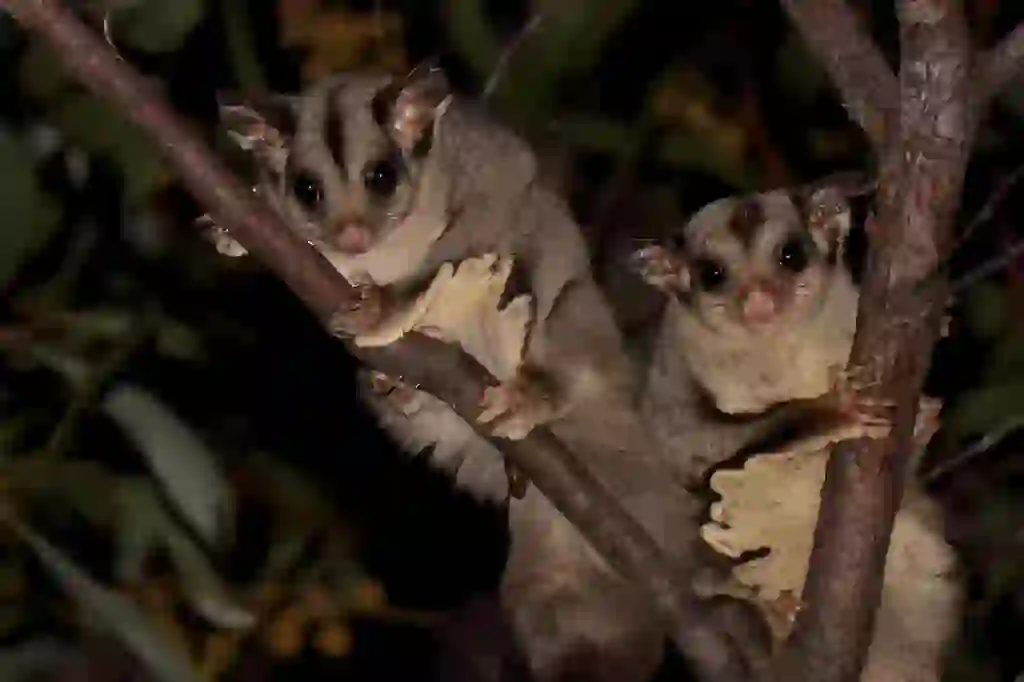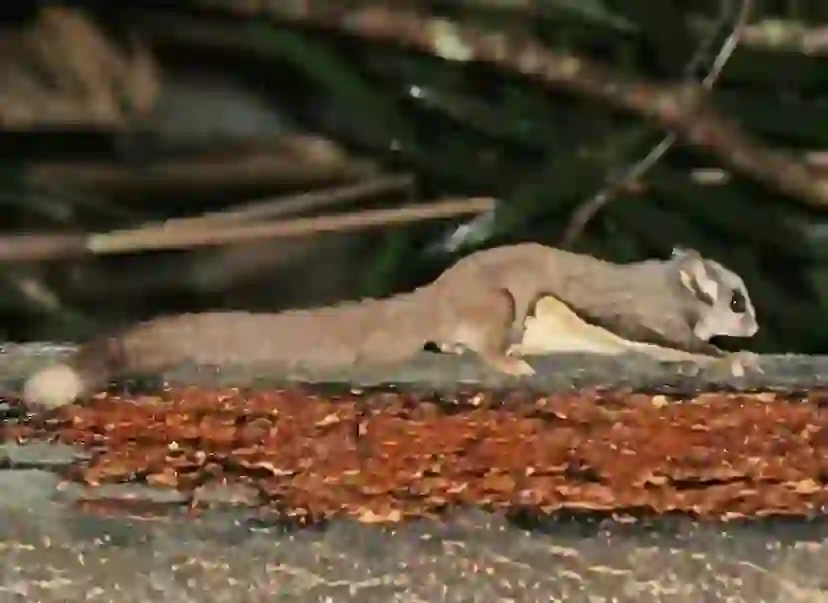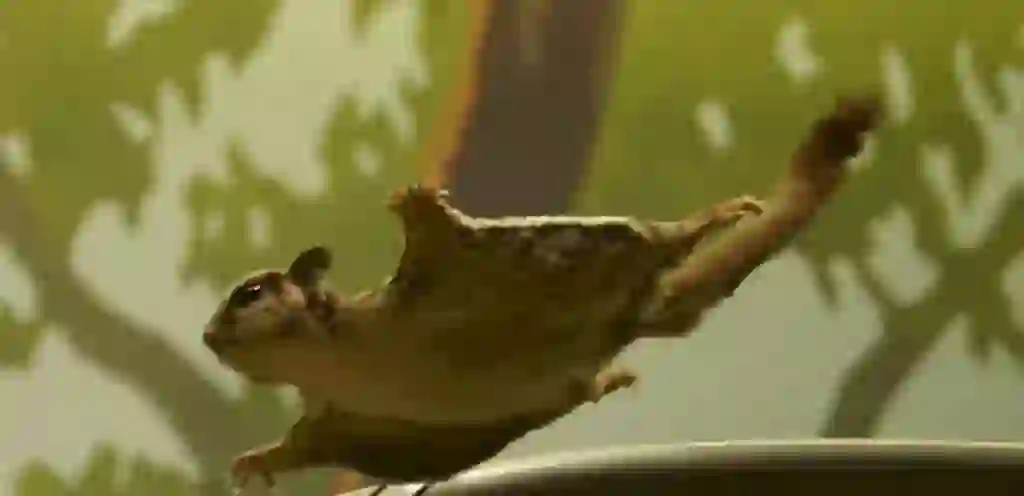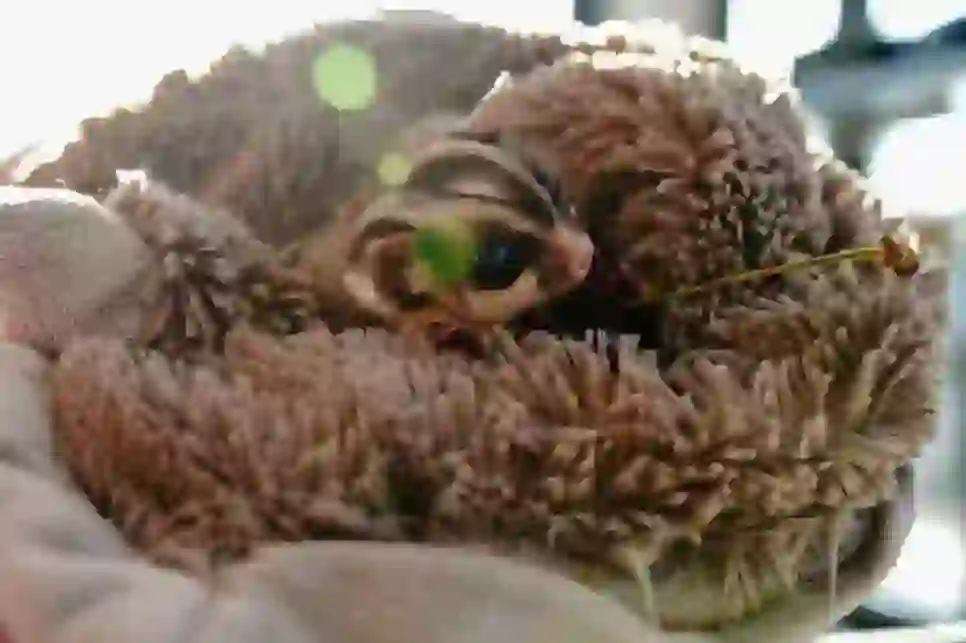
Sugar Glider
Sugar Glider
Sugar Glider
Sugar Gliders are becoming increasingly popular as pets. They have round eyes and a very cute face. Are Sugar Gliders the same as regular squirrels, which look similar? Actually, Sugar Gliders are part of the kangaroo and koala family. These animals have the common feature of raising their young in a pouch in their stomachs. Even if they look similar, they are not necessarily the same species. This phenomenon is called “convergence” in biology. Let’s explore more about Sugar Gliders together!
Sugar Glider Basic Infomation

Mammalia-Marsupialia-Petauridae-Sugar Glider genus. Sugar Glider Length : about 12.7-15.2㎝ Weight : about 95-160kg Tail : about 12-15㎝. Sugar gliders are distributed in northern and eastern Australia, near Papua New Guinea and Tasmania. They live mostly in forests where eucalyptus and acacia grow and spend most of their lives in trees. Sugar gliders are nocturnal animals and start their activities from the evening. During the day, they live in tree holes that they use as their homes with groups of about 6-7 individuals. They live with several females and children for each male leader. Sugar gliders are polygamous. In some cases, it is difficult to distinguish between males and females because they look similar. However, there is an easy way to distinguish them for sugar gliders. The point is to check the male’s head. This is because the male’s head has less hair and is bald, making it easier to distinguish. The reason why the hair becomes thin is that it rubs against the marking to make a scent. The head has a scent gland that emits an odor, so it’s inevitable that the hair will become thin.
Sugar gliders do not have a specific breeding season. The gestation period is only 16 days, so they give birth immediately. The baby’s weight is only 0.2g, so it is born very small. One or two babies are born at a time.
After birth, the baby is raised in the mother’s pouch for about 70 days. Weaning takes about 120 days. Sugar glider babies become completely independent half a year after weaning. In this independence, they live separately from the group they have been living with. Compared to other animals, it seems to take a long time to become independent.

Small and cute pets.
When keeping rare animals, it is necessary to follow the laws established by each country. This time, we will introduce whether it is possible to keep Sugar Gliders at home in Japan. Sugar Gliders are becoming increasingly popular every year. Just looking at their cute appearance is healing. It’s no wonder that many people want to welcome them as family members. Sugar Gliders tend to be very wary at first. However, once they get used to their owners, they become affectionate. Since they live in groups in the wild, it is possible to keep them in groups. If you keep them alone, be sure to communicate with them properly. Be a trusted family member so that Sugar Gliders don’t get lonely.

How many color variations are there?
Sugar Gliders are characterized by their wide variety of color variations. Even the same creature can have a big impression depending on the color of its body. Also, the price varies depending on the color, so be sure to check. ・Standard gray. ・Lutino. ・Mosaic. ・White face blond. ・Cremeino. ・Platinum. ・Albino. ・Ruby leh. We introduced 8 basic colors.
Currently, there are about 20 colors in total. The reason why the number of colors has increased is that they are derived from basic colors. Colors derived from standard gray. ・Black beauty. ・Lion. ・Cinnamon. Colors derived from mosaic. ・Piebald. ・Ring tail. ・Silver mosaic. ・White mosaic. ・True platinum mosaic.

What should I feed them?
Sugar Glider’s diet consists of a main diet of comprehensive nutrition food and a side dish of plant-based and animal-based food. Here are some specific examples. Comprehensive nutrition food is food specifically for Sugar Gliders or insect food for animals. These may be difficult to obtain, so dog or cat food can be used as a substitute. Plant-based side dishes include fruits and vegetables. Instead of giving only certain fruits and vegetables, try various types. Fruits are only side dishes, so be careful not to give too much. If you give only fruits, the nutritional balance will be poor and may lead to illness in the future. Animal-based side dishes include insect mealworms, crickets, boiled eggs, and chicken breast. Insects can be purchased at pet shops. Choose insects that match the size of the Sugar Glider you are raising. Some Sugar Gliders have picky eating habits. If they only eat what they like, the nutritional balance will be biased. Try different foods to increase the variety of foods they eat. Feed them after Sugar Gliders start their activities in the evening. Place the feed in a high place in the cage. Since Sugar Gliders live in trees, try to create a similar environment.

About the breeding environment.
・Breeding cages. The Sugar Glider’s cage should be high enough for them to move around. ・Bait container. The feed container should be placed in a high position like Sugar Gliders eat food in trees in the wild. If it is placed in a low position, excrement such as feces may fall into the feed. ・Water bottle. The water bottle should also be placed in a high position like the feed container. Some of the animals being raised may not drink well from the water bottle. Check if they are drinking well and change to a dish if it seems difficult. ・Corner stage. Corner stages can be used as a place to move around or rest, so set up several of them. ・Bed (pouch). Sugar Gliders need a bed (pouch) because they sleep during the day. There are various types of beds, so prepare several and try them out. It’s reassuring to have a spare because it can get dirty. ・Playground equipment. Toys have increased in number as more people have started raising Sugar Gliders. Representative toys include tunnels, running wheels, and chew sticks. Sugar Gliders also have individuality, so you don’t know what kind of toy they will like. Try various types and find what they like. ・Heat-retention devices. Sugar Glider is tolerant of warm temperatures due to its habitat. However, they are not accustomed to cold. In the winter, please set up a warming apparatus to prevent them from getting too cold. ・Thermometer. Check the temperature with a thermometer to make sure it is comfortable for Sugar Gliders. ・Pet Sheets. Place pet sheets on the bottom of the cage. Cleaning inside the cage is necessary every day. By placing pet sheets, excrement can be cleaned easily.
・Carrying case. A carry case is required when taking Sugar Gliders to the animal hospital. There may be sudden changes in their condition. Prepare in advance so that you can respond to such emergencies.

There are 5 things to keep in mind when breeding!
1)Find an animal hospital that specializes in exotic animals. It is difficult to have Sugar Gliders examined at a general animal hospital for dogs or cats. Specialized knowledge is required, so find an animal hospital that specializes in exotic animals that also handles small animals in advance. 2)Manage the temperature properly. The appropriate temperature for Sugar Gliders is around 24-27℃. Since they are weak against sudden changes in temperature and cold, you need to be careful about the temperature. Use heating equipment to keep the appropriate temperature. 3)Keep in mind a lifestyle that suits Sugar Gliders. Sugar Gliders are nocturnal animals. Since their living rhythm is the opposite of their owners, do not touch them during the day when they are sleeping. Forcing them to wake up can cause stress. If you want to take care of them, play with them at night according to their living rhythm. 4)Understand that toilet training is difficult. Sugar Gliders are difficult to toilet train because they do not have the habit of going to the toilet in a specific place. Therefore, measures such as laying pet sheets so that they can go to the toilet anywhere are necessary. Be careful even when taking a walk inside the room. 5)Understand that Sugar Gliders have a unique odor. Sugar Gliders have scent glands. Therefore, they have a unique body odor with a distinctive smell. Since there are individual differences in odor, you won’t know until you raise them. Males have a stronger odor than females because they have scent glands on their heads and chests. Regardless of gender, the odor becomes stronger after maturity than when they were children. Understand this and raise Sugar Gliders.
Sugar Glider Q&A

Where does the name Sugar Glider come from?
In English, it is called "Sugar Glider," but in Japanese it is actually called "hukuromomonga. Why is it called "hukuromomonga" in Japanese? We will introduce its origin. The name “hukuromomonga” can be divided into “hukuro” and “momonga”. “Hukuro” comes from the pouch on the female’s stomach for raising children. The pouch is a bag for raising children. “Momonga” has the same origin as the momonga (Japanese dwarf flying squirrel) of the squirrel family. Momonga has existed since Japan’s Heian period and was called “momi”. This “momi” is written in kanji as “momi”. It was named after its beautiful hair.
Then, the way it was called changed over time. It changed from “momi” to “momo”, then added the cry of “gua” to become “momongua”. After repeating sound changes, it became the current “momonga”. The name hukuromomonga is a combination of momonga, which looks similar, and the hukuro(pouch) that is a characteristic of its body. Here are some other names for hukuromomonga outside Japan. In English, it is called “Sugar glider”. As the name suggests, it means “gliding animal that likes sweet things”. In Latin, it is called “Peturus breviceps”. “Peturus” means rope crosser or rope dancer. “Breviceps” means small head.

Why does Sugar Glider live there?
Sugar Gliders live in forested areas where eucalyptus and acacia grow. The reason is that there are many tree holes that can be used as a habitat and food can be obtained. Sugar Gliders need a safe place to sleep because they sleep during the day. Also, since they live in groups of 6-7, they need a habitat that can accommodate everyone. Therefore, tree holes are often used as habitats. If it is a forested area, it will be easier to find tree holes. In forested areas, not only plants but also insects and other creatures live. They can obtain not only plant-based food but also animal-based food. They can adjust their own diet and eat. We have learned that forested areas are an essential place for Sugar Gliders to live.

What does Sugar Glider eat?
Sugar Gliders are omnivorous animals. In the wild, they obtain and eat plant-based and animal-based food by themselves. Let me explain more specifically what they eat. Plant-based food. ・Fruits. ・Flower nectar. ・Tree sap. ・Resin. ・Seeds, etc. Animal-based food. ・Insects. ・Reptiles. ・Amphibians. ・Bird eggs and chicks. ・Small animals, etc. In the wild, we have learned that there is a rich variety of food available. With so many things to eat, it seems unlikely that they would get tired of their diet.

Why is the Sugar Glider flying?
There are two reasons why Sugar Gliders fly. 1)To obtain food. Since they spend most of their lives in trees, they also obtain food by flying around the trees. Flying is the fastest way to get food without being taken by other Sugar Gliders. 2)To escape from predators. Sugar Gliders also fly to escape from predators. It is the fastest way to move and has the potential to escape.

How does the Sugar Glider fly?
Sugar Gliders fly by “gliding flight”. This gliding flight is a way of flying slowly down from a high place using the power of the wind. To make it easier to imagine, it’s like flying a paper airplane. Therefore, they cannot fly with their own wings like birds. Instead of bird wings, Sugar Gliders have a membrane called a “patagium”. By spreading this membrane widely, they can adjust the wind and fly to their destination.

How long can a Sugar Glider fly?
Sugar Gliders can glide for about 55 meters. This flight distance is not much different from that of the Japanese dwarf flying squirrel. If the conditions such as tree height and wind are good, it is possible to fly farther than 55 meters.

What kind of animals are the natural enemies of Sugar Glider?
The natural enemies of Sugar Gliders are lurking around them. ・Komodo dragon. ・Eastern quoll. ・Fox. ・Owl. ・Laughing Kookaburra. ・Snake.
You also need to be careful with pet Sugar Gliders. If a Sugar Glider escapes outside, it may be targeted by cats, dogs, birds, and other animals. When taking a walk in the room, be sure to check that the door is locked.

How long does a Sugar Glider last?
The average lifespan of a pet Sugar Glider is about 5-8 years. If the living environment and health are good, some can live for more than 10 years. Wild Sugar Gliders do not know when they will be targeted by predators. Therefore, their lifespan tends to be shorter than that of pet Sugar Gliders. It is difficult for small animals to survive in the natural environment.

What kind of squeak does the Sugar Glider make?
Sugar Gliders make sounds to communicate with their companions. They use not only one type of sound, but also multiple sounds to convey their message. Let me introduce you to three types of sounds. 1)“Jiji” sound. When making this sound, they are threatening or cautious. They may make this sound right after being welcomed into a new environment. Since they are surprised by the unfamiliar environment, please take your time and approach them slowly. 2)“Wanwan” sound. When making this sound, they are calling their companions. They may continue to make this sound when Sugar Gliders start to become active at night. Since the sound is similar to a dog’s voice, it is sometimes mistaken for a dog. 3)“Kupukupu” and “Kyukyu” sounds. When making these sounds, they are expressing their happy or relaxed emotions. They may make these sounds when they are cuddling with their owner or when they receive treats. We have learned that some of Sugar Glider’s sounds can be understood by their owners. Let’s take the time to communicate and get closer to Sugar Gliders through skinship and communication.

What is the difference between Sugar Glider and Japanese dwarf flying squirrel?
There are three major differences between Sugar Gliders and Japanese dwarf flying squirrels. 1)They belong to different species. Sugar Gliders are classified as marsupials. Animals belonging to this marsupial group have a pouch called a “pouch” for raising their young, such as kangaroos and koalas. Japanese dwarf flying squirrels are classified as mammals in the squirrel family. Although they look similar, Japanese dwarf flying squirrels do not have a pouch, so they are different animals. 2)Whether they have scent glands. Sugar Gliders have parts that emit odor called scent glands. These scent glands are used for marking. Some people dislike the unusual odor that Sugar Gliders emit. Japanese dwarf flying squirrels do not have scent glands. If you want to keep Sugar Gliders but are concerned about the odor, Japanese dwarf flying squirrels may be more suitable. 3)Differences in habits. Sugar Gliders can live in groups. Therefore, it is suitable for those who want to keep multiple animals. They also become attached to their owners easily, so it is easy to take skinship with them.
Japanese dwarf flying squirrels can act alone. If you want to keep only one animal, Japanese dwarf flying squirrels may be better. They have a more wild personality than Sugar Gliders, so they don’t always become attached to their owners. Although they look similar, there are also major differences between these animals. If you are considering keeping them as pets, it is important to know the differences. Please consider which animal is suitable for you.

Would you like to become a part of the 'Animalbook.jp'?
Turn your knowledge into Q&A and share it with the world. ※Publication will be activated after purchase. Let's share information together!
Sugar Glider Type of List

Petauridae. 【Sugar Glider genus.】 ・Sugar Glider.
Information
Congratulations! You are the first commenter!

Create Your Favorite List!
Sugar Glider
Save the animals you love! Build your own list to quickly revisit your favorites later.

Would you like to leave a comment?
※Please note: This is for the purchase of rights to post comments within the article.
Find Your Favorites!
Our shop offers a unique and attractive selection of goods themed around various animals.
Sugar Glider References

- PORTA「フクロモモンガの飼い方・特徴・種類~初心者向け~」
- Drツルのエキゾチックアニマル情報室「フクロモモンガってどんな動物?知らないといけない生態と特徴」
- フクロモモンガ・ハリネズミの専門店ピュアアニマル「フクロモモンガのカラーバリエーションと種類について」
- Pet Pedia「フクロモモンガの飼い方、お迎えの仕方、繁殖方法」
- Private Zoo Garden「フクロモモンガ プロフィール」
- anicom you「かわいすぎ!フクロモモンガの飼い方ガイド!種類やごはん、お世話のときに気を付けるべきことは?」
- フクロモモンガの飼育大百科「フクロモモンガの生態について詳しくしろう!」
- ハート動物病院「フクロモモンガについて」
- YAHOO!キッズ 動物図鑑「フクロモモンガ」
- フクロモモンガ・ハリネズミの専門店ピュアアニマル「フクロモモンガの寿命は?病気にならない為の飼育方法は?」
Sugar Glider Introduction of media used

出典:https://commons.wikimedia.org/wiki/File:Sugar_glider.jpg

出典:https://commons.wikimedia.org/wiki/File:Sugar_Glider_JCB.jpg

出典:https://pixabay.com/images/id-1675479/

enemy
出典:https://pixabay.com/images/id-3201423/

enemy
出典:https://pixabay.com/images/id-4576691/

出典:https://pixabay.com/images/id-5448896/

出典:https://unsplash.com/photos/DMqSMHlbwlo

出典:https://commons.wikimedia.org/wiki/File:Sugar_Hold_2737.jpg

Help Enrich Our Animalbook.jp with Your Media!
We are constantly looking to expand and enrich our Animalbook.jp with amazing photos and videos of animals. If you have any media that you'd like to share, please contribute and help us showcase the beauty and diversity of the animal kingdom. Your submissions will be credited and featured in our encyclopedia, reaching a wide audience of animal lovers.




















